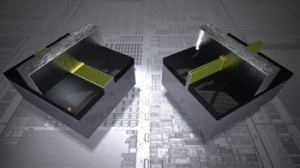Inbox icons, subject line sorcerers, CTA kings – the results are in. The 2025 You Mailed It Awards by Everlytic have crowned their champs, with Old Mutual Rewards and Machine_ taking…
Intel Chip Fabrication Goes 3D-ish

Intel says it has found a way to commercially produce integrated circuit chips in three dimensions, with “Tri-Gate” transistors that are built upwards as well as side-to-side.
No, it’s not the Holy Grail of 3D chip fabrication where you can connect between layers laid on top of each other as well as within them, which would mean radically shorter and simpler signal paths for dramatically more speed, less power consumption.
Rather, Tri-Gate means the channel the current passes through has appreciable height, not just width, allowing Intel to be able to commercially fabricate chips in a new 22-nanometer process, down a giant jump from current 32nm. So significantly smaller, faster, more power efficient.
So it’s more like 2.5D chips.
It’s taken Intel almost a decade to go into production on Tri-Gate technology since it first announced the technique in 2002.
But Intel is still as pleased as punch, as it allows the company to continue to obey Moore’s Law. This law, after Gordon Moore, Intel’s co-founder, is a principle that the number of transistors that can be placed economically on a chip doubles every two years. Every couple of years it looks like physical manufacturing constraints will become an unsolvable barrier, and just in time the semiconductor boffins pull a rabbit out the hat.
“Intel’s scientists and engineers have once again reinvented the transistor, this time utilizing the third dimension,” gushed Intel chief executive Paul Otellini. “Amazing, world-shaping devices will be created from this capability as we advance Moore’s Law into new realms.”
The trend has held true for a half-century and has been at the heart of a mobile lifestyle in which smartphones, tablet computers and other gadgets grow in power while shrinking in size.
“The performance gains and power savings of Intel’s unique 3-D Tri-Gate transistors are like nothing we’ve seen before,” said Intel senior fellow Mark Bohr. “The low-voltage and low-power benefits far exceed what we typically see from one process generation to the next. It will give product designers the flexibility to make current devices smarter and wholly new ones possible.”
Intel is planning on having the next generation of Ivy Bridge processors using this technology out later this year, with commercial availability in 2012.
A pretty cool, if rather dorky, video explaining the tech is here


